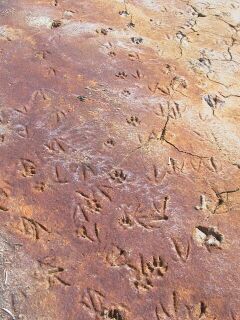 |
Who Done It?
I have selected several photos of tracks and other animal sign that I have
encountered in my wanderings. Each one tells a particular story. Select a
location from one of the menus below. Your task is to view the photo
and try to reconstruct that story. Then compare your interpretation with mine.
Return to Home Page
|
At the water's edge
Rivers, lakes, and ponds are an excellent place to track for
several reasons. For one, receeding water levels will expose
sandy bars and muddy areas that register tracks well. For
another, animals tend to congregate at the water's edge. Some
aquatic mammals like otter and beaver as well as many birds are
rarely found far from water. Carnivores will often make the river
bank part of their daily routine searching for food.
- 1) Sandy River, OR
- 2) Sandy River, OR
- 3) Sandy River, OR
- 4) Sandy River, OR
- 5) Sandy River, OR
- 6) Sandy River, OR
- 7) Sandy River, OR
- 8) Sandy River, OR
- 9) Sandy River, OR
- 10) East Fork of the Hood, OR
- 11) Salmon River, ID
- 12) Salmon River, ID
- 13) Henry's Fork of the Snake River, ID
- 14) Beaver Lake, YNP
- 15) Slough Creek, YNP
- 16) Pebble Creek, YNP
- 17) Netarts Bay, OR
- 18) Toppenish, WA
Mountain Madness
Tracks can be found most anywhere, not just along waterways. Tracking works in many mediums:
dust, grass, broadleaf plants, etc. I call this section "Mountain Madness" because these examples
were found at higher elevation and they are more subtle due to the tracking substrate (novices beware,
these are more difficult puzzles better suited for those with a bit of experience).
Fine Feathered Friends
Birds also leave tracks and other sign. Perhaps they do not capture the attention
that a cougar or wolf might for the casual observer but the experienced tracker knows that
bird sign is an important part of the natural landscape and poses unique challenges.
- 1) Sandy River, OR
- 2) Sandy River, OR
- 3) Sandy River, OR
- 4) Jackson Bottom, OR
- 5) Blue Mountains, OR
- 6) Elk wallow, Gifford Pinchot, WA
- 7) Elk wallow, Gifford Pinchot, WA
- 8) Beaver Lake, YNP
- 9) Netarts Bay, OR
- 10) Netarts Bay, OR
In the Grip of Winter
Winter is a challenging but rewarding time to track. To
identify the species, the tracker must use all the available
clues since a clear, well-formed footprints are rare.
Snow conditions in the northern Oregon Cascades are not always ideal
(snow on the west side sometimes freezes into hard crust affectionately
known as "Cascades concrete"), but winter tracking is still worthwhile.
- 1) Lone Butte, Gifford Pinchot, WA
- 2) Indian Heaven, Gifford Pinchot, WA
- 3) Lone Butte, Gifford Pinchot, WA
- 4) Indian Heaven, Gifford Pinchot, WA
- 5) Indian Heaven, Gifford Pinchot, WA
- 6) Lone Butte, Gifford Pinchot, WA
- 7) Glacier Park, MT
- 8) Glacier Park, MT
- 9) Surveyor Ridge, Hood River, OR
- 10) Mt. Hood, OR
- 11) Newton Creek, Mt. Hood, OR
- 12) Clark Creek, Mt. Hood, OR
- 13) Tigard, OR
In a Warmer Place
Much of the West is desert, an extreme environment that can reveal fascinating stories to the patient naturalist.
Even the eastern portions of Oregon and Washington qualify as desert.
Gaits
Understanding gaits is an important clue in determining what an
animal is doing. When you don't have clear tracks (e.g., in dry
sand or snow), reading the gait may also be your most important
clue for identifying the species. If you have not studied gaits
yet, you may want read the introductory section of a recent
guidebook. For an extensive treatment see Jim Halfpenny's classic
book, A Field Guide to Mammal Tracking in North America or his
Scats and Tracks series.
Other Sign
A good tracker looks for all types of animal sign, not just
tracks.
Return to Home Page
